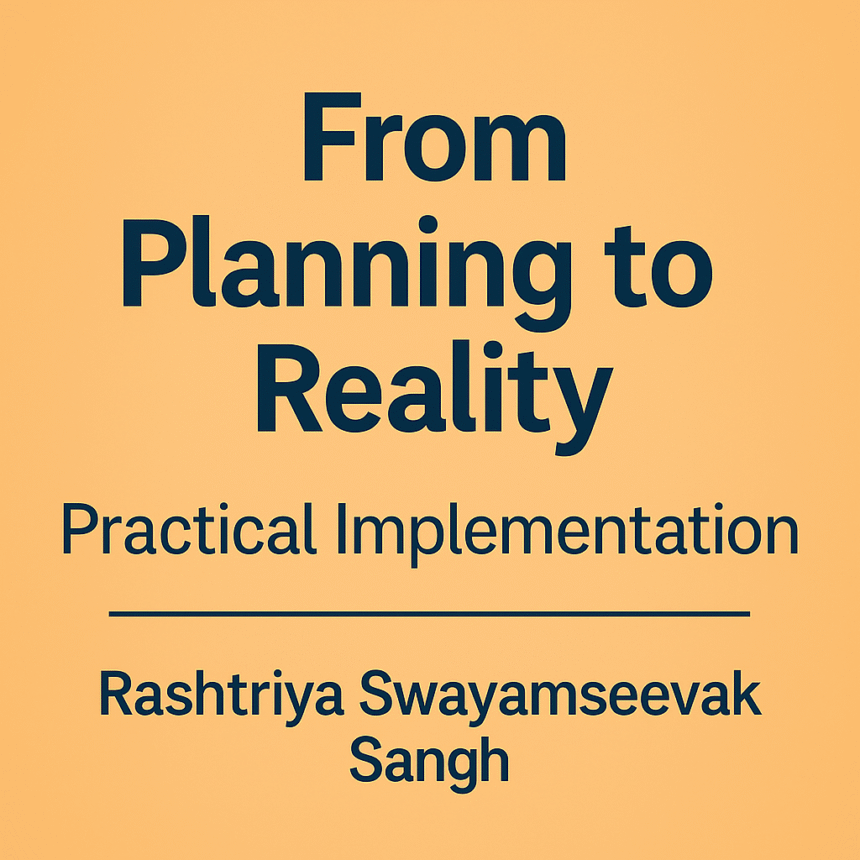From Planning to Reality: Practical Implementation
Part 10: RSS Centenary Sankalp Blog Series
🇮🇳/🇬🇧
Yogah Karmasu Kaushalam: From Planning to Reality
“Yogah Karmasu Kaushalam” — Yoga is skill in action. This principle from the Bhagavad Gita is the soul of the centenary resolutions of the Rashtriya Swayamsevak Sangh. Every activity of the Sangh is inspired by this idea. The commitments made in Bengaluru in 2025 were not lofty declarations alone. The resolution stated clearly: “Therefore, it is our duty.” This is a call to transform vision into action, to journey from planning to reality. It is a call that insists every plan must be more than an announcement; it must take the form of tangible work within society.
The Philosophical Foundation of Implementation of RSS
In earlier discussions, we examined the spiritual foundation (Part 8) and the contemporary challenges (Part 9). Now the central question is this: how can the principles and solutions outlined in the resolution be translated into lived reality? Implementation is not merely a technical exercise but a process rooted in philosophy, discipline, and continuity.
The resolution affirms “a collective life organized with confidence, founded on Dharma.” To make this a reality, clarity of purpose, practicality of methods, realism in timelines, and honesty in evaluation are all essential.
From Resolution to Practice
The first step from resolution to practice is expansion at the grassroots. Branches are not simply gatherings; they are the living cells of the Rashtriya Swayamsevak Sangh’s organizational life. To strengthen them, a three-year plan can be envisioned. In the first year, attention is given to consolidating existing branches and improving their quality. In the second, new areas are reached, with local leadership nurtured patiently. In the third, the new branches are established and stabilized.
To sustain this process, a system of regular monthly review becomes vital. Each month, progress is assessed: how many new branches have started, how many swayamsevaks have joined, how strategies have been adapted to local needs. Digital platforms can aid this process of supervision, without losing the personal touch that is central to the Sangh.
RSS Framework for Qualitative Improvement
Growth in numbers must always be accompanied by growth in quality. Training is the means through which this is achieved. The path from planning to reality is therefore realized at three levels.
First is the level of knowledge and skills. Weekly study circles, vocational training, and exposure to new technologies ensure that swayamsevaks remain relevant to society. Second is leadership and character. Annual camps, workshops, and systems of self-evaluation encourage responsibility and accountability. Third is the youth vision. The next generation must be rooted in values but also equipped to meet global challenges with confidence.
Training is not an event but a continuous journey. It unites knowledge, leadership, and vision into a shared framework, reducing repetition and sustaining growth.
RSS Strategy of Engaging the Good and the Capable
Society has countless individuals of good character—teachers who believe in value-based education, entrepreneurs who practice ethical business, professionals who serve selflessly, and artists who spread culture. The Sangh has always sought to connect such people with broader social work.
The process is gradual. First comes introduction and building of trust. Then comes familiarization with the Sangh’s work. This is followed by participation in smaller events, leading eventually to regular involvement in branch activities. By engaging such capable individuals, society multiplies its strength many times over.
Regional Strategies: Urban and Rural
Strategies must be tailored to context. In metropolitan areas, collaboration with professional bodies, participation in corporate social responsibility initiatives, and wide use of digital platforms are effective. Time-bound programs are best suited to the fast-paced urban lifestyle.
In rural areas, traditional social structures can be harnessed. Service activities related to agriculture and animal husbandry find resonance. Participation in village festivals and fairs strengthens cultural bonds. Creative initiatives at the level of the gram panchayat give direction to local energies.
RSS Efforts for Social Transformation Through Institutions
Large-scale social transformation is not possible without institutions. Schools, healthcare centers, and service organizations are essential anchors.
In education, this means curriculum reform, teacher training, and parent awareness campaigns. In health, it means mobile clinics, the spread of yoga and Ayurveda, and awareness programs on mental wellbeing. These institutions carry forward ideals in ways that directly touch people’s lives.
Establishing Harmony
The resolution emphasizes conduct based on harmony that rejects all forms of discrimination. From planning to reality, this takes the form of practical actions. Shared meals across communities, support for inter-caste marriages, collective celebrations of festivals, and equal opportunities in education and employment build the foundation of harmony.
Economic harmony too must be pursued—through promotion of cottage industries, formation of cooperatives, vocational training, and encouragement of self-help groups.
Integrated Transformation
The principle of fivefold transformation requires a coordinated approach. At the personal level, this means daily prayer and study, self-evaluation through diaries, regular physical exercise, and monthly goal setting. At the family level, this means prayer gatherings, value education for children, spiritual celebration of festivals, and participation in family service projects.
Change at these levels becomes the seed of national transformation, which in turn extends to global outreach.
National and International Dimensions
At the national level, dignified celebrations of festivals, participation in unity programs, respect for the Constitution, and readiness to contribute to national security are practical expressions of patriotism.
Internationally, stronger bonds with Hindu communities abroad, the spread of yoga and Ayurveda, academic exchanges, and the message of peace rooted in Indian philosophy are pathways to global responsibility.
Technology and Digital Platform Adoption by RSS
Technology has become indispensable in moving from planning to reality. Virtual prayer gatherings, online study sessions, and digital satsangs provide new avenues of connection. Content creation in multiple Indian languages, attractive multimedia for youth, and podcasts or webinars ensure that the message reaches far and wide.
Through careful use of digital tools, tradition and innovation can walk together.
Resource and Infrastructure Planning
Implementation demands adequate resources. Human resources must be nurtured through leadership training and division of responsibility. Financial resources must be raised transparently, accounted for carefully, and invested in long-term projects. Physical resources must include permanent branch buildings, community centers, libraries, and training camps built in environmentally sustainable ways.
Quality Assurance and Evaluation
Consistency is ensured through standardization of practices: uniformity in prayers, games, intellectual discussions, and social programs. Training curricula are clearly defined for different levels.
Evaluation is carried out at four levels: individual self-review, peer review, guidance from seniors, and feedback from society. Together, these mechanisms ensure continuous improvement.
Overcoming Challenges, Seizing Opportunities
Implementation inevitably faces challenges—limited time of volunteers, adapting to new technologies, generational differences, and resource constraints. Social misunderstandings and negative propaganda must be countered with transparency and rational communication.
Yet every challenge also presents an opportunity. By aligning with national policies like the New Education Policy, Swachh Bharat, Digital India, and Atmanirbhar Bharat, work gains new relevance. Globally, the growing interest in yoga, Ayurveda, spirituality, and environmental consciousness provides new avenues.
Sustaining Transformation
For long-term stability, second-line leadership must be cultivated, institutional memory preserved, and resources diversified. Knowledge transfer to younger generations, blending traditional wisdom with modern education, and preparing for future challenges are vital.
From Sankalp to Siddhi
Thus, the journey from planning to reality is not abstract. It is rooted in the century-long experience of the Rashtriya Swayamsevak Sangh and in its society-based vision. From expansion to training, from harmony to technology, from national duty to global responsibility—every element comes together in the march from resolution to realization, from Sankalp to Siddhi.
Feature Image: Click here to view the image.
Videos
हिंदी
English
Glossary of Terms
- Rashtriya Swayamsevak Sangh (RSS): A socio-cultural organization in India founded in 1925, known for its emphasis on discipline, service, and national unity.
- Sankalp Patra: A formal resolution document adopted by the RSS during special occasions such as its centenary, outlining commitments and future plans.
- Swayamsevak: A volunteer of the Rashtriya Swayamsevak Sangh who participates in daily and weekly activities of training, discipline, and service.
- Bauddhik Varg: Intellectual sessions or study circles conducted within branches of the RSS, focusing on discussions about history, culture, and social challenges.
- Shikshan Varg (Training Camp): Structured residential or non-residential training camps organized by the RSS for volunteers, emphasizing physical fitness, discipline, and ideological education.
- Gram Panchayat: The elected village-level local self-government body in India that handles community-level administration and development activities.
- Atmanirbhar Bharat: A national policy initiative promoted by the Government of India focusing on self-reliance in economy, production, and innovation.
- Digital India: A government program launched to promote digital infrastructure, digital literacy, and online governance across India.
- New Education Policy (NEP): India’s national education framework introduced in 2020, emphasizing holistic, skill-oriented, and value-based learning.
- Ayurveda: An ancient Indian system of medicine that emphasizes balance in bodily systems through diet, herbal treatment, and yoga.
- Yoga: An ancient Indian practice combining physical postures, breathing exercises, and meditation, aimed at uniting body, mind, and spirit.
- Sankalp to Siddhi: A Sanskrit phrase meaning “from resolution to fulfillment,” symbolizing the journey from planning to realization.
#RSS #Planning #Reality #Unity #HinduinfoPedia
Previous Blogs of the Series
- https://hinduinfopedia.org/sarve-bhavantu-sukhinah-the-spiritual-foundation-of-rss-philosophy/
- https://hinduinfopedia.org/pledge-for-the-world-the-vision-of-a-harmonious-and-organized-hindu-society/
- https://hinduinfopedia.org/centenary-resolution-from-shakha-expansion-to-social-transformation/
- https://hinduinfopedia.org/striving-for-character-excellence-enhancing-shakha-quality/
- https://hinduinfopedia.org/organizing-noble-people-power-of-social-transformation/
- https://hinduinfopedia.org/social-metamorphosis-from-values-to-culture/
- https://hinduinfopedia.org/panch-parivartan-the-five-dimensional-transformation/
- https://hinduinfopedia.org/spiritual-foundation-power-of-sarve-bhavantu-sukhinah/
- https://hinduinfopedia.org/from-struggle-to-solution-facing-modern-challenges/
Related Blogs
- https://hinduinfopedia.org/rashtriya-swayamsevak-sangh-a-pillar-in-modern-hindu-society/
- https://hinduinfopedia.org/sanatana-dharma-secular-and-inclusive-values-of-hindu-philosophy/
- https://hinduinfopedia.in/nathuram-godse-murderer-patriot-or-fractured-youth/
- https://hinduinfopedia.org/ambedkars-buddhist-political-move-divergence-from-gandhi-on-caste-issues/
- https://hinduinfopedia.org/india-china-border-tensions-a-strategic-analysis/
- https://hinduinfopedia.in/gandhis-murder-was-nehru-involved/
- https://hinduinfopedia.in/waqf-act-debate/
- https://hinduinfopedia.com/abrahamic-religions-alliance-how-global-networks-target-indias-democracy/#Modi_the_RSS_and_the_Abrahamic_Narrative_Trap



Leave a Reply